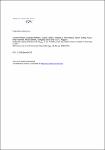Molecular characterization of blaNDM-1 in an Acinetobacter baumannii strain isolated in Germany in 2007
Pfeifer, Yvonne
Wilharm, Gottfried
Zander, Esther
Wichelhaus, Thomas A.
Göttig, Stefan
Hunfeld, Klaus-Peter
Seifert, Harald
Witte, Wolfgang
Higgins, Paul G.
Objectives: To investigate the genetic environment of the metallo-β-lactamase gene blaNDM-1 in an Acinetobacter baumannii isolated in 2007 in a German hospital. Methods: Antimicrobial susceptibility testing was performed and resistance genes were characterized by PCR amplification and sequencing. Transferability of β-lactam resistance was tested by broth mating assays and transformation of plasmids. The genetic background of blaNDM-1 was analysed by primer walking. Typing of the A. baumannii strain was performed by repetitive extragenic palindromic sequence-based PCR (rep-PCR) using the DiversiLab system. Results: The multidrug-resistant A. baumannii isolate harboured β-lactamase genes blaNDM-1 and intrinsic blaOXA-64, but without the insertion sequence ISAba1 often located upstream. Transfer of carbapenem resistance by conjugation and transformation failed. Hybridization of isolated plasmid DNA with blaNDM probes was not successful. Shotgun cloning of whole genomic DNA and sequence analyses revealed that blaNDM-1 was located between two insertion elements of ISAba125. Furthermore, this blaNDM-1-containing transposon structure was integrated into a chromosomal gene encoding a putative A. baumannii major facilitator superfamily (MFS) metabolite/H+ symporter. Conclusions: The metallo-β-lactamase gene blaNDM-1 in this A. baumannii strain was integrated in the chromosome on a new transposon structure composed of two copies of insertion sequence ISAba125. The variability of the genetic environment of blaNDM-1 likely facilitates the rapid dissemination of this gene within many Gram-negative bacterial species.
Dateien zu dieser Publikation
Keine Lizenzangabe
Verwandte Publikationen
Anzeige der Publikationen mit ähnlichem Titel, Autor, Urheber und Thema.
-
2013-07-12ZeitschriftenartikelDNA Uptake by the Nosocomial Pathogen Acinetobacter baumannii Occurs during Movement along Wet Surfaces Wilharm, Gottfried; Piesker, Janett; Laue, Michael; Skiebe, EvelynThe emergence of Acinetobacter baumannii as an increasingly multidrug-resistant nosocomial pathogen largely relies on acquisition of resistance genes via horizontal gene transfer. Here, we demonstrate that many clinical ...
-
2014-07-07ZeitschriftenartikelImpact of Acinetobacter baumannii Superoxide Dismutase on Motility, Virulence, Oxidative Stress Resistance and Susceptibility to Antibiotics Heindorf, Magdalena; Kadari, Mahendar; Heider, Christine; Skiebe, Evelyn; Wilharm, GottfriedAcinetobacter baumannii is a Gram-negative bacterium appearing as an opportunistic pathogen in hospital settings. Superoxide dismutase (SOD) contributes to virulence in several pathogenic bacteria by detoxifying reactive ...
-
2023-04-21ZeitschriftenartikelThe Acinetobacter baumannii website (Ab-web): a multidisciplinary knowledge hub, communication platform, and workspace Karah, Nabil; Mateo-Estrada, Valeria; Castillo-Ramírez, Santiago; Higgins, Paul G.; Havenga, Benjamin; Khan, Wesaal; Domingues, Sara; Da Silva, Gabriela Jorge; Poirel, Laurent; Nordmann, Patrice; Ambrosi, Cecilia; Ma, Chaoying; McClean, Siobhán; Quiroga, María Paula; Alvarez, Verónica E.; Centron, Daniela; Zarrilli, Raffaele; Kenyon, Johanna J.; Russo, Thomas A.; Evans, Benjamin A.; Opazo-Capurro, Andres; Rafei, Rayane; Hamze, Monzer; Daoud, Ziad; Ahmad, Irfan; Rather, Philip N.; Hall, Ruth M.; Wilharm, Gottfried; Uhlin, Bernt EricAcinetobacter baumannii is a Gram-negative bacterium increasingly implicated in hospital-acquired infections and outbreaks. Effective prevention and control of such infections are commonly challenged by the frequent emergence ...

